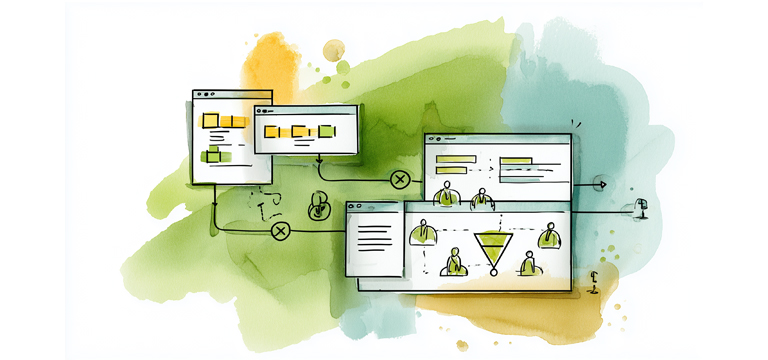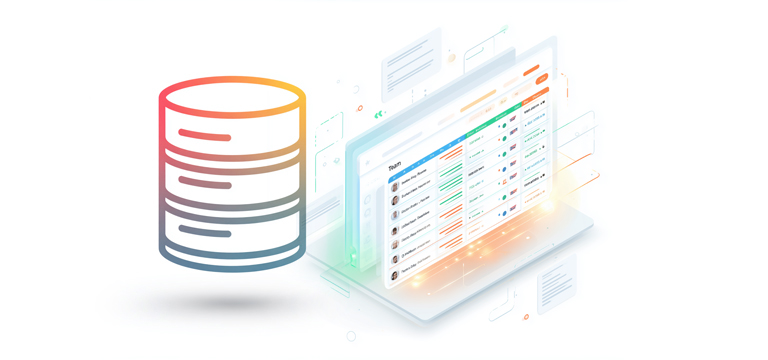Legacy Application
Support &
Modernization
Keep aging systems running while planning the path forward. We stabilize, document, de-risk, and gradually modernize legacy applications so you maintain business continuity while reducing technical debt.
Breathe new life into aging systems. Or plan their retirement.
Legacy application support means maintaining older software systems built on outdated frameworks, languages, or architectures. While gradually modernizing them to reduce risk, improve maintainability, and align with current business needs.
Whether you've inherited an application from another vendor, have an aging in-house system, or face mounting technical debt, we stabilize what's there, document what matters, de-risk critical dependencies, and chart a practical path to modernization that balances cost, risk, and business value.
GET IN TOUCHGET IN TOUCHLegacy Support & Modernization
Stabilize → Document → De-risk → Modernize
A phased approach to legacy application maintenance that reduces risk, improves reliability, and creates a clear path to modernization without disrupting your business.
1. Stabilize: Stop the Bleeding
Fix critical bugs, patch security vulnerabilities, implement monitoring, establish backups, and restore basic operational health.
2. Document: Understand What You Have
Map architecture, document dependencies, catalog technical debt, identify key business logic, and create runbooks for operations.
3. De-risk: Address Critical Weaknesses
Update unsupported dependencies, implement proper error handling, add automated testing, improve security posture, and establish disaster recovery.
4. Modernize: Incremental Transformation
Refactor high-risk areas, migrate to supported platforms, implement modern practices, extract key services, and eventually replace or rebuild, on a timeline that works for your business.
Legacy technologies we support
We've worked with systems built on outdated or end-of-life technologies, from monolithic applications to aging frameworks that lack vendor support. Our team has experience maintaining and gradually modernizing these stacks while keeping business operations running.
Legacy Backend Technologies
- Older.NET Framework (4.x, 3.5)
- Classic ASP, ASP.NET Web Forms
- Legacy Java (Java 8 and earlier)
- Older PHP (5.x, early 7.x)
- Ruby 2.x, Rails 4.x and earlier
- Python 2.7, older Django/Flask
- Legacy Node.js versions
- COBOL, VB6 (maintenance only)

Legacy Frontend Technologies
- AngularJS (1.x)
- jQuery-based applications
- Backbone.js, Knockout.js
- Server-rendered monoliths (JSP, ERB, Razor)
- Flash/Flex (migration planning)
- IE11-dependent applications

Legacy Databases
- Older SQL Server (2008, 2012, 2014)
- MySQL 5.x, MariaDB
- Oracle Database (various versions)
- PostgreSQL 9.x
- Legacy MongoDB versions
- Access databases (migration planning)
- FoxPro, dBase (migration planning)

Legacy Infrastructure
- On-premises servers and data centers
- Windows Server 2008/2012
- IIS 7/8, older Apache versions
- VMware, Hyper-V environments
- Manual deployment processes
- Legacy load balancers

The 90-day legacy takeover plan
When you engage us to take over a legacy application, we follow a structured 90-day plan to stabilize operations and prepare for ongoing support:
- Days 1-30: Discovery & Stabilization
Architecture review, access setup, critical bug triage, security assessment, monitoring implementation, backup verification. - Days 31-60: Documentation & De-risking
System documentation, dependency mapping, technical debt inventory, runbook creation, disaster recovery testing, refactoring of high-risk areas. - Days 61-90: Planning & Optimization
Modernization roadmap, cost/benefit analysis, improvement plan, team training, ongoing support cadence.
Risk & compliance considerations
Legacy systems often carry hidden risks that can derail business operations or create compliance headaches:
- Unsupported Software: End-of-life OS, frameworks, or databases create security and compliance risks
- Knowledge Loss: Original developers gone, minimal documentation, tribal knowledge disappeared
- Regulatory Exposure: GDPR, HIPAA, PCI compliance harder to maintain on old systems
- Integration Brittleness: Modern systems struggle to integrate with legacy protocols and APIs
- Vendor Lock-in: Dependence on legacy vendors who charge premium prices for support
- Scalability Limits: Architecture can't handle current load, let alone future growth
Modernization strategies
Not every legacy system needs a complete rewrite. We assess your situation and recommend the right modernization strategy based on business value, risk, and budget:
1. Maintain & Extend (Status Quo+)
Keep the system running with minimal changes, add monitoring and security patches, document what's there. Best when system has low business criticality or budget is constrained.
2. Incremental Refactoring
Gradually improve code quality, add automated tests, update dependencies, refactor high-risk modules. Modernize piece by piece without disrupting operations. Our recommended approach for most legacy systems.
3. Service Extraction (Strangler Pattern)
Extract key functionality into modern microservices, gradually redirect traffic away from the monolith. Eventually the legacy system "strangles" down to nothing. Best for high-value features trapped in legacy code.
4. Platform Migration
Move to modern platforms without changing architecture, e.g., .NET Framework → .NET Core, on-prem → cloud. Faster than rewrite, less risky than big-bang changes. Good when underlying platform is the main limitation.
5. Gradual Replacement
Build new system alongside old one, migrate users and data in phases, run parallel during transition, eventually decommission legacy. Best for critical systems that can't afford downtime.
6. Complete Rewrite
Rebuild from scratch using modern stack. Highest risk, highest cost, but sometimes necessary when technical debt is insurmountable. We help you decide if it's worth it and plan the transition.
Why choose Singlemind for legacy support
We're not afraid of old code
Many agencies only want greenfield projects. We understand that most businesses run on legacy systems, and we're comfortable working with aging codebases and outdated technologies.
Pragmatic modernization, not dogma
We won't push you toward expensive rewrites when incremental improvements will do. Our recommendations balance business value, technical risk, and budget reality.
Product strategy expertise
We understand that legacy systems exist for a reason. They support real business processes. Our product strategy background means we modernize in ways that serve business goals, not just technical ideals.
Structured takeover process
We've refined a 90-day takeover process that systematically reduces risk, documents knowledge, and establishes stable operations, so you're not dependent on a single person or vendor.
Frequently asked questions
Common questions about legacy application support and modernization services.
We look at several signals: unpatchable security risk, frequent outages, runaway operating costs, difficulty hiring for the legacy tech stack, and how strongly the system blocks roadmap changes. If the system is stable, inexpensive to run, and not limiting the business, focused legacy maintenance may be the right call; otherwise, we propose phased modernization options with clear cost, risk, and value trade-offs.
Yes. This is exactly what our legacy application support offering is designed for. Our 90-day takeover plan includes reverse-engineering architecture and critical flows, instrumenting monitoring, documenting behavior, and identifying risks before we change anything. The goal is to replace “tribal knowledge” with shared, durable documentation and operational runbooks.
Technical debt is the accumulation of shortcuts, outdated dependencies, and architectural decisions that made sense once but now slow you down. In legacy systems, it shows up as high change risk, long lead times, fragile integrations, and difficulty hiring. We quantify that debt so you can decide whether to pay it down incrementally or budget for a more significant modernization effort.
We favor incremental strategies: stabilizing and documenting first, refactoring the riskiest areas, using the strangler pattern to peel off services, or migrating platforms in stages. This lets the existing legacy system continue to support the business while we steadily reduce risk, instead of betting everything on a multi-year rewrite that may slip or miss the mark.
Common paths include “stabilize and extend” for low-criticality systems, incremental refactoring with better tests and tooling, platform migrations (for example, from on-prem to cloud or from legacy.NET to.NET Core), targeted service extraction around high-value domains, and, in rare cases, full rewrites when there is no viable salvage path. We map each path to cost, risk, and business value so you can choose deliberately.
We connect technical realities to business outcomes: risk of outages and breaches, regulatory exposure, opportunity cost of a hard-to-change system, and total cost of ownership compared to modern alternatives. Combined with phased investment options, that analysis gives executives a clear picture of why legacy application modernization matters and how to approach it pragmatically.
A legacy system is software that still runs critical business processes but is built on older technologies, architectures, or practices. Organizations keep them because they work, they embody years of business logic, and replacing them feels risky. Legacy application support and modernization aims to reduce that risk gradually. Stabilizing what exists while creating a realistic path to something more maintainable.
The strangler pattern is a modernization strategy where you gradually build new services around the edges of a legacy system and route specific functionality to them over time. As more capabilities move into the new architecture, the legacy system shrinks until it can be safely retired. It lets you modernize without a dangerous big-bang rewrite by delivering value incrementally and reducing risk step by step.
Related Services
Software Support
Manage IT risks before they hurt your business. We keep your product secure, up to date, and running smoothly, so you can focus on your business.
VIEW DETAILSVIEW DETAILSProduct Strategy
A successful product starts with a clear strategy. We help you shape ideas into a plan that balances user needs, business goals, and technical feasibility for success.
VIEW DETAILSVIEW DETAILS